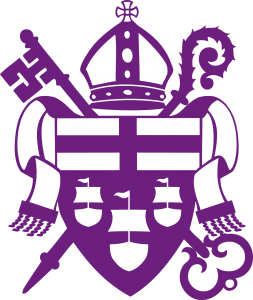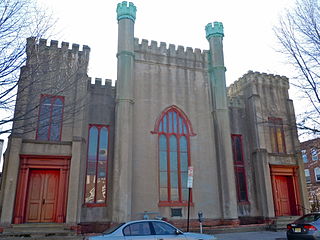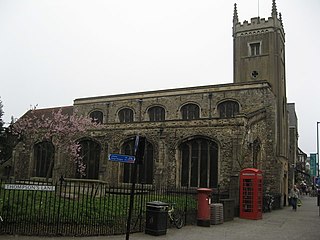A churchwarden is a lay official in a parish or congregation of the Anglican Communion or Catholic Church, usually working as a part-time volunteer. In the Anglican tradition, holders of these positions are ex officio members of the parish board, usually called a vestry, parochial church council, or in the case of a Cathedral parish the chapter.
Churchwardens have a duty to represent the laity and co-operate with the incumbent (or, in cases of vacancy, the bishop). [1] They are expected to lead the parishioners by setting a good example and encouraging unity and peace. They have a duty to maintain order and peace in the church and churchyard at all times, and especially during services, [1] although this task tends to be devolved to sidesmen. [2]
Churchwardens in many parts of the Anglican Communion are legally responsible for all the property and movable goods belonging to a parish church. If so, they have a duty under ecclesiastical law to keep an up-to-date inventory of the valuables, and if applicable a "terrier of the property" (a listing and/or map of the church's lands, known as glebe, some of which may be let). Whenever churchwardens authorise work on the church building having obtained a faculty or to carry out work recommended in the church's Quinquennial Inspection Report, [3] they must record this in the Church Logbook; it is inspected with the inventory. The churchwardens must ensure these logs are ready for inspection in case of a visitation and for periodic inspections.
Priests and their equivalent tend to devolve day-to-day maintenance of church buildings and contents to their churchwardens.
If an incumbency is vacant, the bishop (or the Archdeacon acting on his behalf) will usually appoint the churchwardens as sequestrators of the parish until the bishop appoints a new incumbent. The sequestrators ensure that a minimum number of church services continue to be held in the parish, and in particular that the Eucharist continues to be celebrated every Sunday and on every Principal Feast. This duty is usually discharged by organising a regular rota of a few volunteer clergy from amongst either Non-Stipendiary Ministers from within that diocese or in some cases retired clergy living in or near the parish. The bishop will tend to consult the churchwardens before appointing a new priest to take over the parish; in England there is a set process to follow which also involves representatives of the congregation. [4]
Churchwardens' duties may vary with the customs of the parish or congregation, the canons of the diocese to which the parish belongs, the desires of the priest, and the direction of the parish board or the congregation as a whole. A definition of their duties is that they are "ultimately responsible for almost everything in a church which does not have to be done by a priest. If the churchwarden does not do it himself, then he is responsible for making sure that it is done by someone". [5]
In England, churchwardens have specific powers to enable them to keep the peace in churchyards.
The following are punishable with a £200 fine: [6]
The churchwarden of the parish or place where the offence was committed may apprehend a person committing such an offence, and take them before a magistrates' court. [6] In practice this means they should be aware of these offences and may be expected to conduct a citizen's arrest until police arrive, if appropriate. Until 2003, the offence was punishable by up to two months' imprisonment. [6] However, caution is advised in the use of this power. [7]
Historically, there are two main types of warden: the people's warden(s) (and assistants, if any) are elected annually by the congregation as a whole (at what is called the Annual Vestry Meeting or "meeting of the parishioners"); the rector's warden(s) (and assistants, if any), are appointed by the incumbent. However, this distinction has been abolished in several areas of the Anglican Communion in favour of both wardens being appointed jointly (notably in England, although the incumbent retains the right in some circumstances to appoint one warden).
In some jurisdictions (but not in England) where a parish temporarily has no priest, is not self-supporting, or in which the parish board has been dissolved, wardens are appointed directly by the bishop and are called "bishop's wardens".
The only areas in which wardens almost always have no authority, often proscribed by canon, are music and liturgy, which are considered to be under the exclusive authority of the priest or bishop in charge of the parish. Nevertheless, in England churchwardens have authority to officiate at Morning and Evening Prayer if a priest or licensed lay person is unavailable.
In the Church of England, churchwardens are officers [8] of the parish and officers of the bishop. [1] Each parish elects two churchwardens annually (unless an existing custom in place on 1 January 2002, and which has continued since before 1 January 1925, states otherwise) and they are elected on or before 30 April [9] and are sworn in between being elected and 31 July the same year. [10] Churchwardens are (re-)elected annually at the Meeting of Parishioners and can serve a maximum of six years followed by a two-year break unless the rule [11] is previously suspended by the Meeting of Parishioners.
A few Anglican churches, for historical reasons outlined above, have three churchwardens instead of the usual two; two such examples are All Saints, West Ham and St Margaret's, Barking. [12] Historically, there are also a few churches which retain four churchwardens with St. Mary's, Ecclesfield, Sheffield, as an example. [13]
Some churches may appoint Assistant Churchwardens to help them. These are distinct from Deputy Churchwardens who have a precise role in certain limited cases. [14] The terms "Honorary Churchwarden" or "Churchwarden Emeritus" are sometimes bestowed on retiring churchwardens; these are purely honorary terms and do not allow such a holder to continue to sit unelected on the PCC. [15]
One Church Warden is appointed by the incumbent, whilst another is elected by the Easter General Vestry. Both serve for one year terms, during which they are ex officio members of the select vestry. As well as performing some logistical functions normally associated with a sexton or verger, church wardens have certain constitutional rights and responsibilities: they may convene and chair meetings of the General Vestry or Select Vestry (but only under certain circumstances), and their consent is required for the use of any experimental forms of service and for any visiting ministers who are not in full communion with the Church of Ireland. Church Wardens are also responsible for overseeing the collection during the Offertory, for the presentation of the bread and wine to the officiating priest during Holy Communion, and for the safe custody of church plate.
The canons of some US dioceses permit or mandate the election of all wardens, in which case they are usually referred to as the "senior warden" and the "junior warden". Sometimes, however, the senior warden is known as the "rector's warden" and the junior warden, the "people's warden". In some of the latter cases, the rector's warden is chosen by the rector, while the people's warden is elected by the congregation. Wardens serve for a fixed term, normally one to two years, and are usually automatically members of the parish canonical committee, commonly called the "vestry", and sometimes automatically delegates to the diocesan synod, or convention, as well.
The duties of churchwardens in the Anglican Church of Southern Africa (ACSA) are detailed in Canon 29 of the Canons and Constitution of the ACSA, as follows. [16]
Churchwardens are the officers of the Bishop and the principal representatives of the congregations. Together with the Incumbent they constitute the executive of the Parish Council and have special responsibility in the following matters:
Additional duties and responsibilities may also be specified in the various dioceses of the Province.

A parish is a territorial entity in many Christian denominations, constituting a division within a diocese. A parish is under the pastoral care and clerical jurisdiction of a priest, often termed a parish priest, who might be assisted by one or more curates, and who operates from a parish church. Historically, a parish often covered the same geographical area as a manor. Its association with the parish church remains paramount.
A parochial church council (PCC) is the executive committee of a Church of England parish and consists of clergy and churchwardens of the parish, together with representatives of the laity. It has its origins in the vestry committee, which looked after both religious and secular matters in a parish. It is a corporate charitable body.
A vestry was a committee for the local secular and ecclesiastical government of a parish in England, Wales and some English colonies, which originally met in the vestry or sacristy of the parish church, and consequently became known colloquially as the "vestry". At their height, the vestries were the only form of local government in many places and spent nearly one-fifth of the budget of the British government. They were stripped of their secular functions in 1894 and were abolished in 1921.
The parson's freehold refers to a system within the Church of England in which the rector or vicar of a parish holds title to benefice property, such as the church, churchyard or parsonage, the ownership passing to his successor. This system is to be phased out, under the Ecclesiastical Offices Measure.
A sidesperson, also known as a sidesman, usher, or assistant churchwarden, in Anglican churches is responsible for greeting members of the congregation, overseeing seating arrangements in church, making the congregation queue for communion at the altar in an orderly way, and for taking the collection. In England they are usually appointed by the parochial church council and receive guidance in their duties from the churchwardens.

In the Roman Catholic Church and the Anglican Communion as well as some Lutheran denominations, a rural dean is a member of clergy who presides over a "rural deanery" ; "ruridecanal" is the corresponding adjective. In some Church of England dioceses rural deans have been formally renamed as area deans.

The Diocese of Virginia is the largest diocese of the Episcopal Church in the United States of America, encompassing 38 counties in the northern and central parts of the state of Virginia. The diocese was organized in 1785 and is one of the Episcopal Church's nine original dioceses, with origins in colonial Virginia. As of 2018, the diocese has 16 regions with 68,902 members and 180 congregations.
In English ecclesiastical law, the term incumbent refers to the holder of a Church of England parochial charge or benefice. The term "benefice" originally denoted a grant of land for life in return for services. In church law, the duties were spiritual ("spiritualities") and some form of assets to generate revenue were permanently linked to the duties to ensure the support of the office holder. Historically, once in possession of the benefice, the holder had lifelong tenure unless he failed to provide the required minimum of spiritual services or committed a moral offence. With the passing of the "Pastoral Measure 1968" and subsequent legislation, this no longer applies, and many ancient benefices have been joined into a single new one.

The Anglican ministry is both the leadership and agency of Christian service in the Anglican Communion. "Ministry" commonly refers to the office of ordained clergy: the threefold order of bishops, priests and deacons. More accurately, Anglican ministry includes many laypeople who devote themselves to the ministry of the church, either individually or in lower/assisting offices such as lector, acolyte, sub-deacon, Eucharistic minister, cantor, musicians, parish secretary or assistant, warden, vestry member, etc. Ultimately, all baptized members of the church are considered to partake in the ministry of the Body of Christ.
In the United States, the history of the Episcopal Church has its origins in the Church of England, a church which stresses its continuity with the ancient Western church and claims to maintain apostolic succession. Its close links to the Crown led to its reorganization on an independent basis in the 1780s. In the nineteenth and early twentieth centuries, it was characterized sociologically by a disproportionately large number of high status Americans as well as English immigrants; for example, more than a quarter of all presidents of the United States have been Episcopalians. Although it was not among the leading participants of the abolitionist movement in the early 19th century, by the early 20th century its social engagement had increased to the point that it was an important participant in the Social Gospel movement, though it never provided much support for the Prohibitionist movement. Like other mainline churches in the United States, its membership decreased from the 1960s. This was also a period in which the church took a more open attitude on the role of women and toward homosexuality, while engaging in liturgical revision parallel to that of the Roman Catholic Church in the post Vatican II era.

Established in 1703, St. Michael's Church in downtown Trenton, Mercer County, New Jersey, United States, is a founding parish of the Episcopal Diocese of New Jersey. Its present building located at 140 North Warren Street was built in 1747–1748, and was renovated in 1810 and 1847–1848. It was listed on the National Register of Historic Places on April 29, 1982 as St. Michael's Episcopal Church.

St Mary's Church is in the civil parish of Coddington, Cheshire, England. The church is recorded in the National Heritage List for England as a designated Grade II listed building. It is an active Anglican parish church in the diocese of Chester, the archdeaconry of Chester and the deanery of Malpas. Its benefice is combined with that of St Chad's, Farndon.
Trusteeism and the trustee system are practices and institutions within certain parishes of the Catholic Church in the United States, under which laypersons participate in the administration of Ecclesiastical Property. When laypersons are among the trustees, the Church seeks agreement with the civil authorities to have the property administered under principles of canon law.
The annual meeting of parishioners is held yearly in every parish of the Church of England to elect churchwardens and deputies for the forthcoming year. The meeting must be held by 31 May and is commonly held immediately prior to the annual meeting of the parochial church council. It is the last remnant of the old vestry meeting.

St Mary the Virgin is a 13th-century Anglican parish church in Northolt, London Borough of Ealing. It is on a slope shared with Belvue Park, the site of a 15th-century manor house — both overlooked the old village of Northolt. It is one of London's smallest churches, its nave measuring 15 yards (14 m) by 8 yards (7.3 m). The church was built around 1290 and was expanded over the centuries, with the chancel being added in 1521, the spired bell tower in the 16th century, and a gallery at the west end of the church in 1703. Twin buttresses were erected against the west wall around 1718 to alleviate concerns that the church could slip down the hill. The internal beams are original and the bells date from the 17th century. The church was constructed from a variety of materials; the nave incorporates clunch, flint and ironstone, and the mouldings of the doors and windows are made from Reigate Stone.

Vicar is a title given to certain parish priests in the Church of England and other Anglican churches. It has played a significant role in Anglican church organisation in ways that are different from other Christian denominations. The title is very old and arises from the medieval arrangement where priests were appointed either by a secular lord, by a bishop or by a religious foundation. Historically, but no longer, vicars share a benefice with a rector to whom the great tithes were paid. Vicar derives from the Latin vicarius meaning a substitute.

The parish with its parish church(es) is the basic territorial unit of the Church of England. The parish has its roots in the Roman Catholic Church and survived the English Reformation largely untouched. Each is within one of 42 dioceses: divided between the thirty of the Canterbury and the twelve of that of York. There are around 12,500 Church of England parishes. Historically, in England and Wales, the parish was the principal unit of local administration for both church and civil purposes; that changed in the 19th century when separate civil parishes were established. Many Church of England parishes still align, fully or in part, with civil parishes boundaries.
A rector is, in an ecclesiastical sense, a cleric who functions as an administrative leader in some Christian denominations. In contrast, a vicar is also a cleric but functions as an assistant and representative of an administrative leader.

St Clement's is a Church of England parish church in central Cambridge. The church is a Grade II* listed building.
Jonas Pilling was vicar of the former Church of St Mark, Old Leeds Road, Huddersfield, West Yorkshire, England, from 1905 to 1926. He was the notorious subject of many newspaper articles about the fourteen-year dispute between Pilling and his congregation, the absence of churchwardens, other officials and choir, the dwindling of his congregation and the dereliction of the church building. This occurred in an industrial environment of great poverty, where there was "plenty of scope for church work." At the 1921 Bishop's Commission, he mentioned his fear of "plottings."